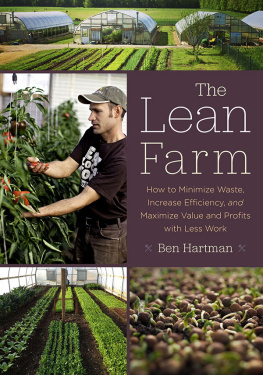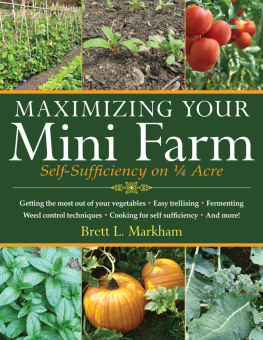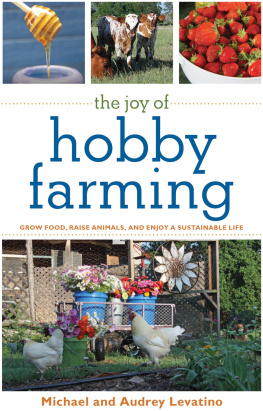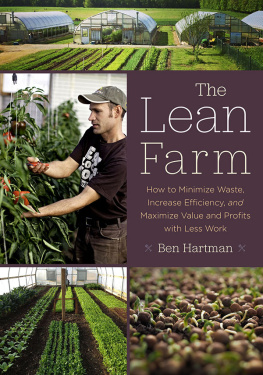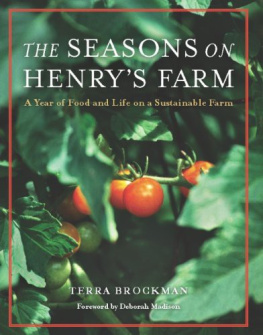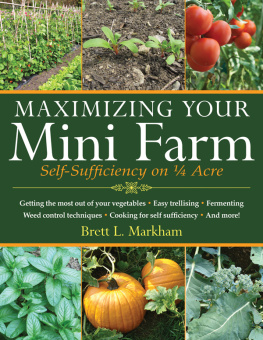
Amy Franceschini:
To my mother and father for allowing me to see the many paths in the fork.
Daniel Tucker:
To my parents for living right and making time for everything that matters.
Text copyright 2010 by Amy Franceschini and Daniel Tucker.
Foreword copyright 2011 by Mark Bittman. Photographs copyright 2010 by Anne Hamersky, except as noted.
Photographs on (top) copyright by Bonsai Matt.
Photographs on copyright by Baltimore Development Cooperative.
All rights reserved. No part of this book may be reproduced in any form without written permission from the publisher.
ISBN 978-1-4521-3402-4
The Library of Congress has cataloged the previous edition as follows:
ISBN 978-0-8118-6711-5
Design by Brian Scott
Illustrations by Corinne Matesich
Transcription: Carla Avitabile, Alex Harker, Corrine Matesich,
Ashley Weger
Chronicle Books LLC
680 Second Street
San Francisco, California 94107
www.chroniclebooks.com
Contents
Introduction
During the summer of 2009, we visited the twenty farms featured in this book. Individually, each reveals some of the most exciting currents and possibilities for how we could perceive and receive the food we eat at this specific time in history. Collectively, they form a portrait of the complexity of farming in the United States today. We spent time with the individuals who grow food, in the places where they workthe environments that shape their crops and livesand through these interviews, we hope to depict a sense of place, people, and action to challenge and inspire you.
We traveled from the shores of the Pacific Coast of California bordering Silicon Valley to the post-industrial landscapes of Holyoke, Massachusetts. The disparity of each farm amplified when we physically visited each location: the arid terrain of the Southwest in Patagonia, Arizona, compared to the gridded agricultural landscape surrounding Californias San Joaquin Valley; urban gardens and farms in sprawling metropolises like Atlanta, Georgia, to rural farms on rolling hills like those found in Kendall, Wisconsin. Topping it off, the impressive agricultural cultures we encountered in the Rocky Mountains of Colorado and the Appalachian Mountains of North Carolina reminded us of challenging microclimates that people have been carefully adapting to for thousands of years.
In traveling across the United States, we found great inspiration from the struggles against corporate agriculture and the dramatic turns toward different food systems taking place. We stated from the start, when emailing farmers and organizations across the country, that We want the way the food system works to change! So we chose to seek out and meet with people across the country who are doing just that!

The twenty projects presented in this book profile various approaches. They reflect different and sometimes opposing philosophies. Many place themselves within subcultures currently working under banners such as food justice, sustainable agriculture, and local-foods movement and share their philosophies through education and demonstration. For some, its through direct action or policy battles, and for others, their physical work and very local distribution is quite enough.
We chose to use the interview format as a way to bring the voices of the farmers and activists to you as directly as possible. While each profile can stand on its own, this collection is an exhibit of the people and places that are bound together by a common interest in food and its link to every aspect of life.
For each farm, we cover essential details: scale, working habits, influences, and organizational structure. We discuss philosophies, public policy, history, soil, and distribution methods. By understanding how these individuals are creating solutions for their lives and the lives of those whom they care about, we feel more optimistic about our future. We present their stories here because we know that a new food system can only emerge if the diversity and complexity that these folks embody are part of the discussion.
Definitions for terms in bold type can be found in the glossary starting on .
We hope that you are as inspired by the individuals who have shared their voices as we are. Lets hear from them, learn from them, celebrate them, and join them. Lets farm together now!
Foreword: Farms Matter
Mark Bittman
There has been a progression in the rediscovery of good food in the United States. In this process, which has taken place over the last fifty years, we first began to understand and appreciate that it was possible for home cooks to reproduce wonderful and classic food, primarily, but not exclusively, food based on French and American traditions. Soon thereafter, we recognized that restaurants could become temples of good cooking from all over the world.
But it wasnt long before we realizedwere talking late 70s, early 80s herethat the best cooking had a foundation that had been almost forgotten: good ingredients. Thus followed, in typical American fashion, an obsession with the best ingredients, which sometimes meant the most coddled (think of early heirloom tomatoes) and sometimes meant the most expensive (think truffles).
We have matured, or at least, we are maturing. We have worked our way through and even worshipped natural, organic, and local ingredientsas well as celebrity chefs and ultramodern cuisineand we have come to understand that there are no panaceas. But along the way we have also come to see this always-obvious but sometimes overlooked fact: There is a fundamental process in producing fundamentally good ingredientsthose raised, to use a clichd but appropriate phrase, in harmony with nature.
That process, of course, is farming. But producing real ingredients takes a special kind of farming, and the farming that dominated the landscape by the 1960sand which has for the most part grown worse with each passing decadehas raped the land, tortured animals, exploited workers, and disregarded the needs of consumers, all the while producing inferior food.
We need to do exactly the opposite, and part of the way the American food landscape has changed, and the greatest hope for its future, is the dedication of new farmers whove recognized that, committed to it, and become the new pioneers. These are the farmers who speak here.
Farming has always been workhard work, in fact. But though mechanization has made the physical aspects of farming easier, the loss of traditional methods has in some ways made things more challenging. The modern, so-called efficient way to do thingsindustriallyis obviously unsustainable; we need another way.
The chances are good that if youre reading these words you know that already. You probably also know that a small but increasing number of farmers, represented in this book, are combining traditional ways with contemporary knowledge to search for and come up with a series of new systems that produce good food while treating the environment, animals, workers, and consumers with respect. Doing this while still making a living, in fact having a good life, is the great agricultural challenge facing the world in the twenty-first century.
There are no easy answers. Its one thing to restructure a farm and make things work in a relatively populated portion of the Midwest, such as Minneapolis or Kansas City; there is infrastructure and a nearby market, and a more traditional ratio of farmers to urban citizens. Its an entirely different thing to try to address the needs of a nation where four out of five of us live in cities. Unlike Kansas City (population 150,000), for example, New York (population 8,000,000) is not surrounded by farmland and farmers.
Next page

